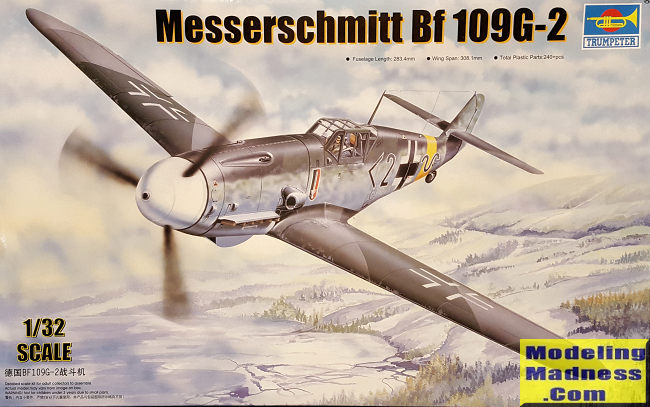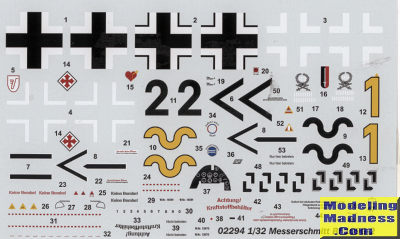
Trumpeter 1/32 Bf-109G-2
| KIT #: | 02294 |
| PRICE: | $40-45.00 delivered |
| DECALS: | Three options |
| REVIEWER: | Scott Van Aken |
| NOTES: | 2011 release. Includes p.e. frets and rubber tires |

| HISTORY |
The G-1, produced from February 1942, was the first production version of the G-series and the first production Bf 109 with a pressurized cockpit. It could be identified by the small, horn-shaped air intake for the cockpit compressor just above the supercharger intake, on the left upper cowling. In addition, the angled armour plate for the pilot's head was replaced by a vertical piece which sealed-off the rear of the side-hinged cockpit canopy. Small, triangular armour-glass panels were fitted into the upper corners of this armour, although there were aircraft in which the plate was solid steel. Silica gel capsules were placed in each pane of the windscreen and opening canopy to absorb any moisture which may have been trapped in the double glazing. The last 80 G-1s built were lightweight G-1/R2. In these GM-1 nitrous oxide 'boost' was used, and the pilot's back armour was removed, as were all fittings for the long-range drop tank. A few G-1 flown by I./JG 1 are known to have carried the underwing 20 mm MG 151/20 cannon gondolas.
The G-2, which started production in May 1942, lacked the cabin pressurization and GM-1 installation. Performance-wise it was identical to the G-1. The canopy reverted to one layer of glazing and incorporated the angled head armour used on the F-4, although several G-2 had the vertical type as fitted to the G-1. Several Rüstsätze could be fitted, although installing these did not change the designation of the aircraft. Instead the "/R" suffix referred to the G-2's Rüstzustand or equipment condition of the airframe, which was assigned at the factory rather than in the field. There were two Rüstzustand planned for G-2s:
The rack and internal fuel lines for carrying a 300 L (80 US gal) under-fuselage drop-tank were widely used on G-2s, as were the underwing 20 mm MG 151/20 cannon gondolas. Several G-2s were fitted with the ETC 500 bomb rack, capable of carrying one 250 kg (550 lb) bomb. The final G-2 production batches built by Erla and Messerschmitt Regensburg were equipped as tropical aircraft (often referred to as G-2 trop), equipped with a sand-filter on the front of the supercharger intake and two small, teardrop-shaped metal brackets on the left side of the fuselage, below the cockpit sill. These were used as mounts for specially designed sun umbrellas (called Sonderwerkzeug or Special tool), which were used to shade the cockpit.
A total of 167 G-1s were built between February and June 1942, 1,586 G-2s between May 1942 and February 1943, and one further G-2 was built in Győr, Hungary, in 1943. Maximum speed of the G-2 was 537 km/h (334 mph) at sea level and 660 km/h (410 mph) at 7,000 m (22,970 ft) rated altitude with the initial reduced 1.3 atm rating. Performance of the G-1 was similar, but above rated altitude the GM-1 system it was equipped with could be used to provide an additional 350 horsepower. With his G-1/R2, pilot R. Klein achieved 660 km/h (420 mph) at 12,000 m (39,370 ft), and a ceiling of 13,800 m (45,275 ft).
The following variants of the G-1 and G-2 were produced:
| THE KIT |
 Even
though Hasegawa does pretty much all of the G series of 109s in 1/32 scale, one
that it does not produce is the G-2 variant (even though you could use the G-4
boxing for this). For that, we have to turn to Trumpeter.
Even
though Hasegawa does pretty much all of the G series of 109s in 1/32 scale, one
that it does not produce is the G-2 variant (even though you could use the G-4
boxing for this). For that, we have to turn to Trumpeter.
Trumpeter has a rather
interesting reputation amongst modelers. This may well be due to their earlier
and extremely fussy kits in this scale. I can recall all the issues I had with
their 1/32 F4U-4 due to the miserable hinges that were required to install the
flight control surfaces. Thankfully, that sort of nonsense is lacking in this
kit.
Putting together the fuselage means that you attach the engine cowling covers. There are no props to hold these up if you want to display all those parts you put into the engine so you'll need to fabricate those. Modelers who want to leave these covers closed can skip putting a lot of parts on the engine, though the block is needed to hold the guns and exhaust.
Rudder and elevators are separate but tabbed to only fit in the neutral position, just like the ailerons. Quite a few of the small p.e. bits are used on the canopy and surround. The area behind the seat has a p.e. cover held in place by a two piece p.e. strap. The head armor is also photo etch. There is no hinge area shown to keep the canopy open, but a resourceful modeler will be able to devise something.
With the fuselage and wings completed, they are joined. There is a rack and drop tank. The tank strap is photo etch and unbelieveably, the little mounting points on the tank are also separate. The last things to be attached are the landing gear, the build up lower cowling piece (which does have a p.e. radiator screen), and the gun gondolas (if you are using them).
 Instructions
are well done with Gunze and RLM color information. All three markings options
are in RLM 74/75/76 and since they are on the Russian front, they have yellow
lower wing tips and cowling with a yellow fuselage band. Trumpeter provides a
large full color markings and decal placement guide to go with this. The box art
plane is Gunther Rall's JG 52 aircraft from 1943. You also get another JG 52
plane from summer 1942 and one from JG 3 in a942. Decals are nicely printed with
each of the tail swastikas in four pieces. I recommend aftermarket for this
marking. There are also aftermarket decal sheets for the G-2, though they are
not as widespread as for other 109 variants.
Instructions
are well done with Gunze and RLM color information. All three markings options
are in RLM 74/75/76 and since they are on the Russian front, they have yellow
lower wing tips and cowling with a yellow fuselage band. Trumpeter provides a
large full color markings and decal placement guide to go with this. The box art
plane is Gunther Rall's JG 52 aircraft from 1943. You also get another JG 52
plane from summer 1942 and one from JG 3 in a942. Decals are nicely printed with
each of the tail swastikas in four pieces. I recommend aftermarket for this
marking. There are also aftermarket decal sheets for the G-2, though they are
not as widespread as for other 109 variants.
| CONCLUSIONS |
| REFERENCES |
https://en.wikipedia.org/wiki/Messerschmitt_Bf_109_variants#G-1,_G-2
December 2020
Copyright ModelingMadness.com. All rights reserved.
If you would like your product reviewed fairly and fairly quickly, please contact the editor or see other details in the Note to Contributors.
Back to the Main Page Back to the Review Index Page Back to the Previews Index Page